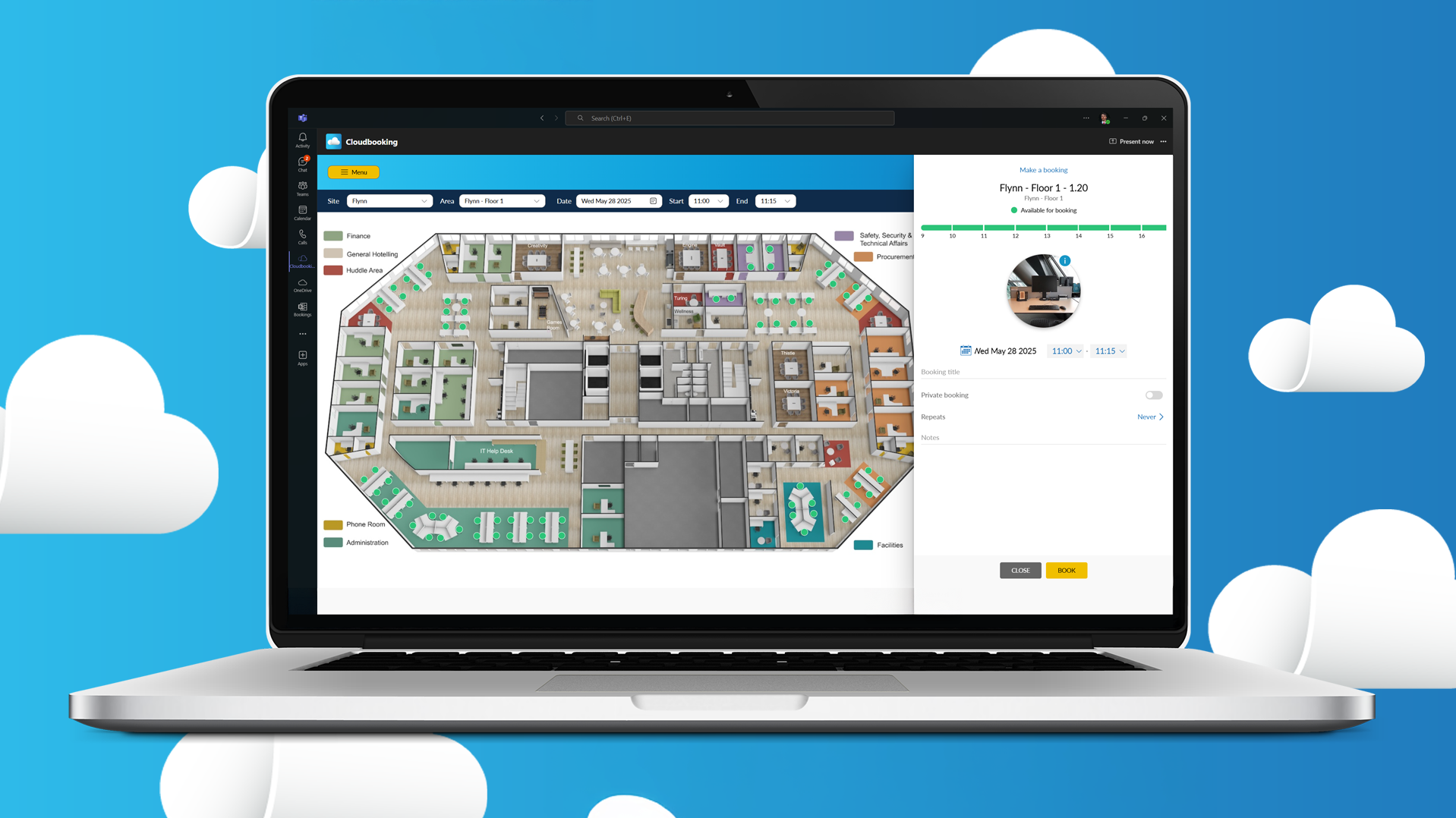
Smart workplaces are becoming the norm in the modern workplace. Smart technologies and integrations are being adopted by businesses to enhance their workflow, improve the employee experience, and reduce operational costs. Smart offices are driven by data and connect people with real estate and integrations for seamless workflow and connectivity. This article will explore the smart office, the tools and technologies it comprises, and the benefits it can offer an organization.
What is a Smart Office?
A smart workplace, or smart office, enables a more productive and cost-effective workflow through intelligent and connected technologies. The smart workplace uses connected technology and analytics to create a working environment that is specifically equipped for the needs of those working within it at any given time.
Key Features
A smart office may include various elements and features, depending on the needs of the specific work environment and its employees. The tools that comprise a smart office may be designed to do a combination of the following:
· Help employees to find and book workspaces to meet their needs
· Help managers to analyze space utilization
· Help meetings run more productively – virtual meetings and video conferencing included
· Enhance collaboration
· Help remote workers increase productivity
· Reduce operational costs
· Reduce carbon footprint at work
A key feature of the smart workplace is that it is designed to respond intelligently to the needs and preferences of those using the space. Over time, the smart office will learn how people like to use the space and their preferences. It will begin to respond automatically to these needs based on data gathering and analyses.
The primary purposes of the smart office are to enhance the experience of all those using the space and provide intelligent insights which can be used to make further improvements and inform business decisions. The smart office essentially gathers information that can be used to help businesses reduce finances, function more efficiently, and enhance the employee experience.
The technologies and tools in a smart office are combined to offer a smart way of working driven by data. It provides workers with practical tools that help to automate simple tasks and connect people more easily.
How Integrations Increase Efficiency in a Smart Office
Smart workplaces incorporate and combine various technologies and tools to facilitate automated work, wherever possible, and support a more productive and efficient workforce.
Investment in smart office technology has been linked to increases in employee performance and accelerated company growth. The use of automation and artificial intelligence tools helps to minimize tedious, menial tasks and encourages creativity and innovation.
The smart working environment helps to improve employee satisfaction in several ways. As mentioned above, one of these ways is by automating tedious tasks and freeing up employees to focus on more meaningful work. In addition, the smart office is designed to make employees feel as comfortable as possible while at work and boost productivity.
Smart technology and tools allow employees to optimize their workspace, adjusting it to the perfect temperature, lighting, and noise levels, for example. When workers are more comfortable, they tend to work more productively and efficiently.
Smart office technology allows leaders to easily monitor their everyday business processes, measure and analyze core metrics and use this information to streamline their workflow. Space utilization data can inform decisions about office layout and respond efficiently to the needs of those working within the office. When everything flows more efficiently, the overall output from employees is increased.
In the smart office, employees can view 3D floor maps and colleague location and availability data. These intelligent insights can save hours of wasted time over the course of a year as people are easily able to find who they need and contact them. This helps to increase efficiency and improve workflow.
Smart office integrations allow several mobile apps and tools to be integrated into one easy-to-use system, with various elements interacting with one another. This provides employees with everything they need in one simple location and reduces the need for additional training to learn different systems. Having tools that are simple to use and easily accessible from any site helps employees work efficiently and productively wherever they are located.
Smart Office Solutions: Tools and Integrations
Smart offices include several hardware devices such as IoT sensors, video equipment, smart screens, computers, mobile devices, and more. These devices are used to gather data and help employees access the integrated system and make the most out of the tools it offers.
Smart offices use cloud-based software as this provides enhanced accessibility and security for remote and mobile workers and those based in the office. This is an essential factor since agile and flexible working is on the rise in the post-pandemic world. Systems used by organizations must be easily accessible by employees wherever they are located.
The smart working environment often integrates space utilization data which helps managers and facilities teams to respond to the needs of workers. It also allows leaders to better understand how the workplace is being used and use this information to redesign a workplace that more accurately meets the needs of those working within it.
Space utilization data is helpful for both leaders and employees and encompasses a range of tools. IoT sensors can gather information about who is using which aspects of the physical workspace and make necessary adjustments. For example, lights and heating can be turned off automatically in spaces that are not being used. This will, of course, reduce utility costs and carbon emissions. Another example would be facilities teams preparing conference rooms in advance, using booking data entered by those who arranged the meeting.
Employees can have access to a simple app to locate colleagues and easily book an appropriate workspace in advance or at a moment’s notice. They can see what types of spaces are available and who will be working in that area. They can see which areas will be busier and choose their desk according to the type of work they need to get done.
Managers can use the data and analytics tools to assess how the physical space is being used, respond to the needs of their team members, and design spaces which more accurately reflect the way their employees want to use the area.
Visitor management tools can also be integrated to allow for ultimate control and awareness over who is in the workplace at any given time. Visitors can use the mobile app to book in and wayfinding tools to get to where they need to be. Car park management tools can also be integrated to ensure every area of the physical workplace is managed and monitored effectively.
Collaboration and connectivity tools can be integrated to ensure everyone can connect easily with those they need to work with, so teamwork is not compromised in the hybrid workplace. Organizations can easily integrate workplace management software with their favorite connectivity tools so employees can continue using the platforms they are familiar with, such as Slack or Microsoft Teams, for example.
How Smart Devices and Technology Connect People and Real Estate Through Integrations
Smart workplaces are all about effective integrations. This includes the integration between tools and data systems and the integration between teams and individuals. It often consists of the integration between different companies, as seen with the rise in outsourcing entire departments such as HR, accounts, or IT.
In smart workplaces, people are connected to real estate and one another in a way that improves their experience within the workplace and enhances their collaboration. Organizations can choose one cloud-based tool they need within their organization, and then – providing it is a good product – they should be able to customize the tools they wish to integrate with it.
For example, the customer may choose a Cloudbooking solution to enable flexible workers to reserve desks ahead of schedule on days they want to work in the office. The customer should have a solution custom-created to meet their needs. Not only will they have desk booking capabilities, but they can also integrate a wide range of other features and their favorite connectivity tools to create the perfect smart office for their unique needs.
Any smart working environment should be specifically designed to meet the organization’s needs because this is its intended purpose, to enhance the user experience. Generic solutions will not provide organizations with maximum benefits. Instead, they must consider what their unique needs are concerning how they operate. Then, they can seek solutions with the appropriate integrations for maximum benefit.
Smart Office: Smart Solutions
Smart workplaces are the future of hybrid working. With more people demanding increasingly flexible ways of working post-pandemic, companies should be investing in smart office tools to protect their business and help attract and retain talent. The smart office will also be a key contributor in the fight against climate change and assisting companies to remain competitive in challenging economic times.
Cloudbooking’s workspace management technologies can create a smart office for your organization. Contact us now for a no-obligation product demo.


